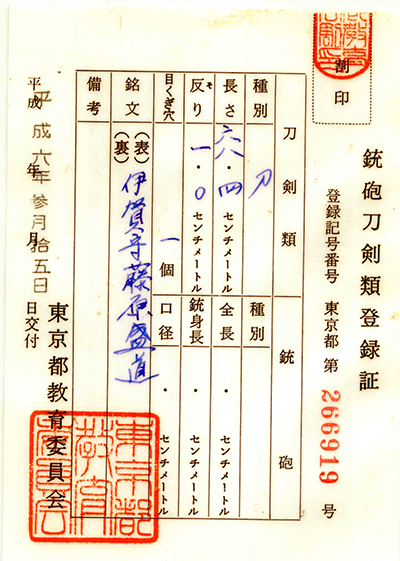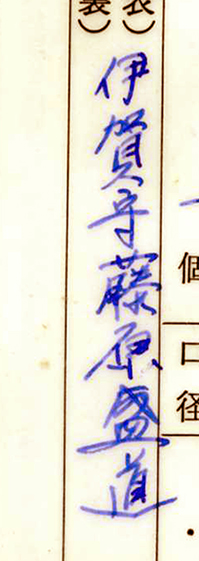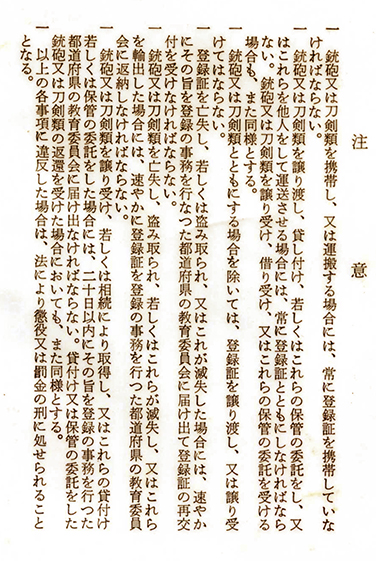Great Katana 刀
Katana かたな in Shirasaya 白鞘 No Kami Fujiwara Morimichi 盛道 Edo 江戸時代 Kanbun era 寛文
Katana blade:
Nagasa: 69 cm.
Sori: 1.1 cm.
Moto-haba: 3.1 cm.
Saki-haba: 1.8 cm.
Moto-gasane: 0.55 cm.
Saki-gasane: 0.4 cm.
Hamon: Notare
Blade condition:
As can be seen in the pictures. There are no major flaws worth mentioning, very light minimal dots and creases not important everything according to the age of a well polished blade preserved through the centuries. The polishing is not recent (maybe from the Shirasaya and Habaki time) but it is well preserved, revealing the fine Hada and the quality of the Hamon.
Perfect razor edge.
Mei:
Soruga or (Soriga or Iga) no Kami Fujiwara Morimichi can read in Nakago Mei
Morimichi 2 generations
Country (KUNI) Period (JIDAI): Mino Gifu-Owari . Edo period 江戸時代 first half year. Kanbun (1661-1673)
Morimichi generations. Honorary title no-kami: "No Kami" was an honorary title given to those who became worthy by possessing a mastery very top in sword forger.
The maker’s name Morimichi lasted three generations.
In concordance with the study of Iwata Atou [Owari Tokofu] the first-gen Morimichi was born in Eiroku era about still in the Muromachi period where it is now the Gifu prefectura initiating a lineage of excellent and famous swordsmith. to become an Okakaekaji for Owari domain in 1610 already in the beginningof the Edo period. It is said that the first-gen Morimichi was related to Mutsu no Kami Omichi, the founder of Mishina school, a prestigious school in Kyoto. The second-gen Morimichi was originally from Mino province but eventually settled in Owari province active in Bushido during the early Edo period, there was much demand for swords among high-class Samurai like Morimichi. Owari domain was known as Tokugawa Gosanke (徳川御三家), closely connected to Tokugawa Shogunate in Edo city.
The first generation MORIMICHI 盛道 with Suruga-no-kami 駿河守 title was born as we have said above during early Eiroku era in Gifu, Mino province as a son of smith MORIMICHI 盛道 who belonged to MUROYA 室屋 branch of Seki-Shichi-Nagare group 関七流.
He is reportedly a relative smith of Mutsu-no-kami DAIDO 陸奥守大道, initial name was KANEMICHI 兼道, who was the founder of Mishina school during Bunrokuk era (1592-95) with his four sons Iganokami KINMICHI 伊賀守金道, in Yamashiro, Rai KINMICHI 来金道, Tanbanokami YOSHIMICHI 丹波守吉道 and Echunokami MASATOSHI 越中守正俊.
MORIMICHI 盛道 reportedly went up to Kyoto in his early age then he moved from Gifu to Nagoya on after Nagoya castle relocation in Keicho 15 (1610).
We assume this blade was originally made for a high-class Samurai in Kanbun (寛文) was a Japanese era (年号, nengō, "year name") after Manji and before Enpō.
Shirasaya - Habaki and Bukuro:
The Shirasaya is much more modern, probably from the time of the last polishing that was done in the Showa period. The high-quality Habaki is solid made Sterling Silver (strong and heavy) and is no doubt also from the same period.
The condition of the Shirasaya and the Habaki is impeccable.
Bukuro (Katana bag) is made of cotton with natural red/purple dyeing with interior lined with another coarse cotton fabric as natural as is usual in good inner bags.
Original Japanese documentation: Kyoiku-inkai paper
Sealed copy of Prefectural (Kyoiku-inkai) Registration Card with the writing of blacksmith signature (no Kami Fujiwara Morimichi) included. In order to legally own a sword in Japan it has to be registered in accordance with the Ju-to-ho 銃刀法
Ref.: Katana 107
|


